What is employee participation and how to increase it?

Do you know what separates a good employee from a great one?
It’s not just the skillset – it’s engagement.
Engaged employees are willing to go the extra mile to get the job done. They consistently exceed expectations and inspire others with their enthusiasm.
But how do you create an environment with that kind of dedication?
That’s where employee participation comes in.
Do you know what separates a good employee from a great one?
It’s not just the skillset – it’s engagement.
Engaged employees are willing to go the extra mile to get the job done. They consistently exceed expectations and inspire others with their enthusiasm.
But how do you create an environment with that kind of dedication?
That’s where employee participation comes in.
What is employee participation?
Employee participation (EP) refers to employees actively contributing their knowledge, ideas, and perspectives to various aspects of the company. It can include contributing to decision-making processes, proposing solutions to problems, and offering feedback on existing processes.
By leveraging the workforce’s collective expertise and experience, employee participation improves decision-making, problem-solving, and, ultimately, the company’s success. It creates a more engaged and innovative work environment.
Participating employees:
- Don’t just follow orders—they come up with ideas and add to company knowledge
- Contribute to decisions that affect their work and the organization as a whole
- Are more invested in the company’s success since their ideas are valued
Employee participation can be broken down into formal and informal structures. Formal methods have a set structure and process for employees to contribute. They include:
- Quality circles: Small groups of employees meet regularly to discuss improving their work and solving problems together.
- Suggestion schemes: Programs that ask employees to submit ideas on improving a company in exchange for financial or encouragement awards.
- Continuous improvement teams: Teams of employees who work on projects to make the company’s processes, products, or services better and more efficient.
Informal methods include:
- Open door policies
- Conversations via internal communication platforms
- Regular anonymous surveys
- Mentorship programs
- Public acknowledgements, like shout-outs
Employee participation vs employee involvement
Employee participation and employee involvement are ways to engage employees in a company. However, they differ in scope and approach.
- Employee participation refers to employees actively taking part in business activities or projects. It often involves team-based tasks where everyone contributes their skills and ideas towards a common goal.
For example, forming a team to brainstorm solutions is a form of participation.
- Employee involvement goes deeper by integrating employees into the company’s decision-making. It means employees have a say in decisions that can influence the direction of their work and the company. Involved employees might attend management meetings, provide policy feedback, or join strategic committees.
Involvement gives employees a sense of ownership, increasing motivation, job satisfaction, and innovation.
Note: While participation can involve some decision-making through feedback and ideas, it doesn’t necessarily involve the deeper level of influence seen in employee involvement. Employee involvement is where employees have a more substantial say in shaping company direction.
To conclude, participation focuses on engaging employees in tasks and activities. Involvement adds one extra layer—emphasizing their role in decision-making and shaping the company’s direction.
Benefits of employee participation
Employee participation makes employees feel more involved and listened to. It leads to a happier, more motivated workforce that is better at their jobs.
Employees also feel less stressed because they have a say in how things are done and get help from colleagues.
Basically, it’s a win-win for both employers and employees!
Benefits of employee participation for employers include:
- Increased productivity: Employee participation promotes engagement, innovation, and a sense of ownership. According to a Gallup study, companies with engaged employees are 23% more profitable.
- Improved morale and lowered absenteeism: Employee participation improves morale by making workers feel valued and heard. In return, absenteeism is lower by 78%.
- More innovation: Employee participation improves innovation by encouraging new ideas and creative solutions. Research shows that diverse teams are 39% more likely to outperform their less diverse rivals financially.
- Stronger team relationships: Participation improves workplace relationships by nurturing communication and trust among employees. This is crucial since 75% of employees find teamwork and collaboration “very important.”
- Better decision quality: Decisions made with input from a broader group of employees tend to be more well-rounded and informed. Also, decisions made and executed by diverse teams deliver 60% better results.
- Cost savings: Involving employees in decision-making can reduce the need for external hires. Their deep understanding of the company makes their insights practical and cost-effective.
- Greater employee retention: High levels of participation and engagement can lead to increased employee retention as engaged teams experience 59% less turnover.
- Empowerment and skill development: Participation allows employees to develop new skills and take on more responsibilities. LinkedIn says 94% of employees would stay longer if their company invested in their career development.
Benefits of employee participation for employees include:
- Increased engagement and motivation. Employees who feel their voice is heard and their ideas are valued tend to be more invested in their work. This can increase motivation, productivity, and a sense of ownership over their tasks.
- Greater job satisfaction. Feeling like a valued part of the team and having a say in how things are done can increase job satisfaction.
- Improved decision-making. Employees often have valuable insights into a company’s operations, and involving their perspectives in decisions leads to better solutions.
- Improved skills and development. Participation in decision-making and problem-solving helps employees learn and develop new skills. This can improve their career prospects.
- Stronger bonds with colleagues. Working together helps employees build stronger relationships, reduce stress, and improve job satisfaction.
- Reduced stress and burnout. Employee participation reduces stress and burnout by giving workers a sense of control and support. It makes them feel valued and involved in their work.
COLLECT
10 strategies to increase employee participation
These 10 strategies will help you to increase employee participation:
1. Establish open communication
Effective communication makes employees feel valued and heard, increasing participation rates. It nurtures trust and inclusion, encouraging active participation. Regular updates and idea sharing connect employees to company goals and decisions.
Anonymous feedback platforms allow all employees, including introverts, to respond without fear.
To achieve open communication:
- Host stay interviews – one-on-one meetings between employees and leaders
- Use tools like HeartCount that allow anonymous suggestions and feedback
- Encourage managers to be approachable and available for informal discussions
- Regularly share company updates, goals, and progress with all employees
- Use newsletters to communicate important information and employee contributions
- Schedule regular feedback sessions where employees can voice their opinions and suggestions
- Involve employees in decision-making by seeking their input on important matters
Effective internal communication improves employee engagement. Transparent information sharing and two-way dialogue improve employee participation and commitment.
2. Conduct employee surveys
Surveys allow employees to voice their opinions and concerns, making them feel valued and heard. This creates a sense of ownership and involvement in the company’s direction.
Surveys can identify what hinders participation. Addressing these issues with better communication or training programs can raise engagement.
Conducting surveys shows that employee voices matter and cultivates a transparent work environment. This encourages employees to share ideas, take initiative, and contribute more, leading to higher engagement and productivity.
Suggestions for conducting employee surveys:
- Conduct surveys periodically to gather employee feedback. Combine weekly pulse checks with personal and custom surveys to get the whole picture
- Use HeartCount for anonymous and confidential submissions to ensure honest feedback
- Implement changes based on the feedback received
- Inform employees about the actions taken in response to their feedback
- Regularly check in with employees to see if changes have had the desired effect
- Combine digital surveys and in-person sessions for a comprehensive approach

Companies that listen to their employees more often see higher participation and satisfaction. Also, companies that share the results of their employee listening are 2x more likely to achieve their business goals. They are also 9x more likely to have managers who make significant changes based on feedback.
What are good employee survey participation rates?
Good employee survey participation rates are usually between 70% and 80%. Rates above 90% are considered exceptional.
Ideal employee survey participation rates according to business size are:
| Company size | Ideal participation rate |
| Small companies (< 500 employees) | 80 to 90% |
| Mid-sized companies (500 to1000 employees) | 70 to 80% |
| Large companies (>1,000 employees) | 65 to 80% |
Achieving a 100% participation rate isn’t always ideal. It can mean employees feel forced to respond, leading to biased answers and reduced data quality.
3. Empower employees with decision-making authority
When trusted to make decisions about their work, employees feel valued and engaged. This autonomy motivates them to contribute actively, as they see their efforts impact the company’s success.
Delegating tasks based on expertise increases commitment, satisfaction, and productivity.
To achieve it:
- Delegate responsibilities based on employees’ strengths and expertise
- Allow employees to lead projects and make key decisions
- Support employees in taking the initiative and proposing solutions
- Provide training to equip employees with the skills needed to make informed decisions
- Offer regular feedback and support to help employees grow in their roles
- Set clear boundaries on the scope of their decision-making to avoid confusion.
Employees with decision-making power feel more prepared for the future. This authority creates ownership and adaptability, amplifying participation in shaping the company’s future.
4. Recognize and reward participation
Acknowledge your employees’ contributions to enhance their morale and motivation. Public praise, shout-outs in newsletters, and formal awards make them feel valued and respected. Offer gift cards or extra time off to incentivize employees to participate actively.
Recognition shows employees their input is important and creates a positive atmosphere. 87% of employees say meaningful recognition increases job satisfaction and increases participation.
Some recognition ideas you could use include:
- Public praise in team meetings
- Company newsletters
- Formal awards presented at company events
- Tangible rewards, like gift cards, bonuses, or extra time off
- Personalized recognition. For example, if an employee loves sports, a ticket to a game would be a good reward. A book lover might prefer a gift card to a bookstore.
- Encourage employees to nominate and recognize each other’s contributions
- Provide continuous feedback and appreciation for employees’ efforts
5. Provide development opportunities
Skilled employees are more confident and capable of contributing to discussions and initiatives. Continuous learning helps them grow and encourages active participation.
Training and development opportunities can include:
- Workshops and courses on leadership, communication, problem-solving, and decision-making skills
- Online learning platforms and courses
- Mentorship programs where experienced employees can guide newer team members
- Coaching sessions to help employees develop specific skills
- Individualized career development plans that align with employees’ personal and professional goals
- In-house training programs tailored to the company’s needs and culture
- Support employees in obtaining relevant certifications to improve their skills and career prospects
Development opportunities are crucial for employee engagement and participation. Engaged learners are more likely to feel growth, achieve career goals, and adapt to change.
6. Organize collaboration between departments
Encouraging cross-functional collaboration helps employees from different departments work together. It breaks down silos and creates a more cohesive work environment. This approach brings diverse perspectives, enhancing creativity and problem-solving.
Companies with strong collaboration grow 22% higher revenue than those with siloed structures. Promoting collaboration uplifts employee participation and brings significant business benefits.
To achieve and improve collaboration:
- Form teams with members from different departments
- Organize regular meetings with representatives from various departments.
- Use project management tools to ease teamwork
- Conduct joint workshops and training sessions
- Assign projects that require collaboration from multiple departments
- Allow employees to work in different departments temporarily
- Establish common goals that need teamwork across departments
- Plan social and team-building activities for employees from different departments
- Acknowledge and reward successful collaborative projects.
7. Encourage innovation
Encouraging innovation improves employee participation by creating a culture that values creativity. Employees feel more engaged and empowered when they have set times to work on new ideas. Freedom to explore without pressure helps them share their ideas.
Suggestions to encourage innovation:
- Give employees time to focus on creative and innovative projects
- Encourage employees to brainstorm and develop new ideas together
- Allow employees to experiment with their ideas without immediate pressure to implement them
- Recognize and reward the best innovative ideas and projects
There is a direct relationship between employee engagement and innovation. Engaged employees drive innovation by suggesting improvements. Innovative companies, in turn, promote employee engagement. This creates a cycle where engagement and innovation reinforce each other.
8. Gamify participation
Gamifying makes participation more engaging and fun for employees. Challenges, competitions, and interactive platforms encourage employees to share ideas and collaborate. Participation feels like a game and promotes more active engagement.
Gamification affects employee engagement and motivation. 83% of employees who undergo gamified training feel motivated. In contrast, 61% of those with traditional training feel bored and unproductive.
Some of the ideas you can use to gamify participation:
- Set up work-related challenges for employees to solve
- Organize friendly competitions around specific tasks or projects
- Display top contributors on leaderboards to motivate others
- Give digital badges for achieving certain milestones or contributions
- Encourage a healthy competitive spirit among teams or individuals
- Provide rewards for top performers
9. Lead by example
Senior executives and managers who participate in daily work set a positive example for the rest of the company. Their behaviour conveys the company’s commitment to inclusion and open communication. Employees are more likely to participate when they see their leaders practising what they preach.
To lead by example:
- Attend and contribute to team meetings and brainstorming sessions
- Take part in creativity and problem-solving workshops
- Share thoughts, feedback, and updates with employees
- Encourage open dialogue to make employees feel comfortable speaking up
- Acknowledge and appreciate employee participation and ideas
- Be approachable to encourage direct communication
According to Gallup, employees whose managers set clear expectations have 17x the odds of being highly engaged. This shows active, high-performing leaders create a more engaged and participative workforce.
10. Emphasize the impact of participation
Show employees that their contributions make a difference. When employees see their ideas lead to positive changes, they feel valued and encouraged to contribute.
Sharing success stories of employee ideas shows their value and inspires others to participate.
For example, the Adecco Group’s employees used social media to boost brand awareness and recognition. By promoting the company online, they increased visibility and engagement, reinforcing the positive impact of employee participation on business success.
To highlight the impact of participation:
- Share examples of how employee ideas have positively impacted the company
- Present detailed case studies that show the direct effects of employee contributions
- Create a visual display to recognize and celebrate notable contributions
- Include sections in company newsletters highlighting successful employee participation and its results
- Discuss the impact of employee contributions in regular company-wide meetings.
- Show employees how their feedback has been implemented and the results.
- Recognize employees in front of their peers during meetings or events
Measuring the impact of employee participation
Measuring the impact of employee participation shows how engaged and committed employees are. Effective employee participation can improve productivity, morale, and retention rates.
Retention and turnover rate
The retention rate tells you how many employees stay, while the turnover rate tells you how many employees leave the company in a given period.
Here’s how to calculate them:
- Turnover rate = (Number of departing employees / Average number of employees) x 100
- Retention rate = (Number of employees retained / Number of employees at the beginning) x 100
High participation leads to higher retention rates because employees feel valued and satisfied. Low participation can lead to higher turnover as employees feel undervalued and disconnected.
- A high retention rate (90% or above) is generally considered good.
- A lower turnover rate (less than 10% annually) is desirable.
Track these rates to see if more participation keeps employees longer and lowers turnover costs.
Productivity and performance data
Productivity shows how much work employees get done. Performance data includes the quality and efficiency of their work.
Productivity metrics include:
- Output per employee: Measures the average output produced by each employee
- Formula: Total Output/Number of Employees
- Revenue per employee: Measures the average revenue generated by each employee.
- Formula: Total Revenue/Number of Employees
Performance metrics are relevant to an employee’s role and company goals.
Increases in productivity and performance compared to previous periods suggest a positive impact.
Employee engagement surveys
To better understand participation, include the following questions in the employee engagement survey:
- Involvement in decision-making:
- On a scale from 1 to 5, how often do you feel your input is considered in department decisions?
- Do you have enough opportunities to contribute ideas and suggestions at work?
- Collaboration and teamwork:
- How often do you collaborate with colleagues on projects?
- Do you feel that our company encourages and values teamwork?
- Feedback and communication:
- How often are you asked for feedback on workplace processes and policies?
- Do you feel comfortable voicing your opinions and suggestions to your manager?
- Empowerment and autonomy:
- To what degree do you feel empowered to make decisions in your role?
- Do you have the autonomy to choose how to complete your tasks?
- Recognition and rewards:
- Are your contributions to team discussions and decisions recognized?
- Do you feel rewarded for taking initiative and participating in company initiatives?
In addition to the employee engagement surveys, the HeartCount app allows you to create custom surveys to gauge employee participation.
Customize questions, select specific teams or individuals, set expiration dates, and decide whether responses will be anonymous.
Once you have collected survey responses, analyze employee participation:
- Sort responses to see how much employees participate in different teams and departments. Spot patterns showing where participation is high or low.
- Check how participation levels relate to productivity, job satisfaction, and retention rates. Use statistical tools to find significant links between participation and these outcomes.
- Compare participation across different job roles, seniority levels, and departments. Find out which groups feel more or less involved in decision-making.
- Share the data with management and employees. Use visuals like charts and graphs to highlight important points.
- Create plans to improve participation in areas where it is low. Introduce initiatives like workshops, suggestion programs, and collaborative projects.
- Track how these strategies affect participation levels. Conduct follow-up surveys to measure progress and make necessary changes.
Use tools like HeartCount that provide anonymous and confidential options for replies and enable you to analyze employee participation effortlessly. This ensures that employees feel secure in providing honest feedback.

Innovation and improvement
Innovation metrics that showcase employee participation include:
- Number of new ideas submitted tracks the number of new ideas proposed by employees. This metric helps gauge the level of creativity and initiative among employees. Many submitted ideas show employees are willing to contribute to the company’s growth and improvement.
- The number of implemented ideas measures how many proposed ideas are used. Tracking this shows how well the company evaluates and applies suggestions. The higher the number, the more the company accepts employee suggestions.
- Improvement rate is the percentage of implemented ideas that result in measurable improvement. This metric assesses the effectiveness of implemented ideas. A higher improvement rate shows that implemented ideas improve the company’s performance.
- Formula: (Number of implemented ideas with measurable improvement/Total number of implemented ideas)×100
What is the required minimum percentage of employee participation?
The minimum percentage of employee participation for most countries in the US is 70%. If a company wants to offer health insurance through the Small Business Health Options Program (SHOP), at least 70% of its eligible employees must enrol in the plan. This minimum can vary by state.
You can use the MPR Calculator to check your eligibility if you run a small business.
There is usually no minimum participation rate for benefits other than health insurance. Yet, some employers set participation goals for wellness initiatives or retirement savings plans.
UNDERSTAND
Encourage employee participation with HeartCount!
By nurturing a culture of participation, you can improve innovation, morale, productivity, and employee retention. Remember, the key lies in creating a work environment where employees feel valued, heard, and empowered.
Ready to get started?
- Conduct an employee survey to assess your current participation levels
- Develop a plan to address areas where participation is low
- Implement strategies like open communication, recognition programs, and collaboration initiatives
- Track your progress and make adjustments as needed
With commitment and effort, you can create a workplace where employees are actively engaged and contribute their best work.
Ready to increase employee participation in your organization? HeartCount can help you make it happen.









